Time to cut through all of the chatter.
The .300 Blackout (BLK) has been called everything from the 5.56 killer to the black mamba.
Designed by Advanced Armament Company as a replacement for the MP5SD, a 9mm sub-machine gun favored by special ops, it had to have more power, same sound level, and compatibility with the M4/AR-15.
The .300 BLK did exactly that…and gave civilians a serious upgrade for the AR-15.
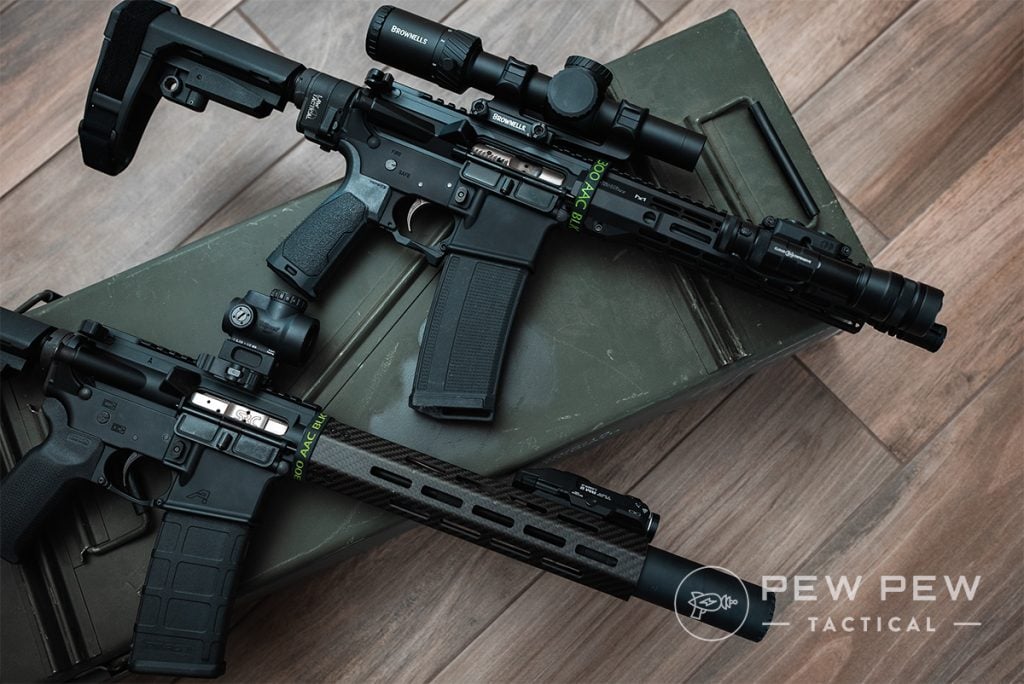
But should you consider an AR or upper chambered for .300 BLK? What are the pros/cons?
We’ll walk you through the ballistics, cost, and real-world power of the .300 BLK vs 5.56/.223. And then if you want more…we have our standalone articles on the best uppers, ammo, & even optics.
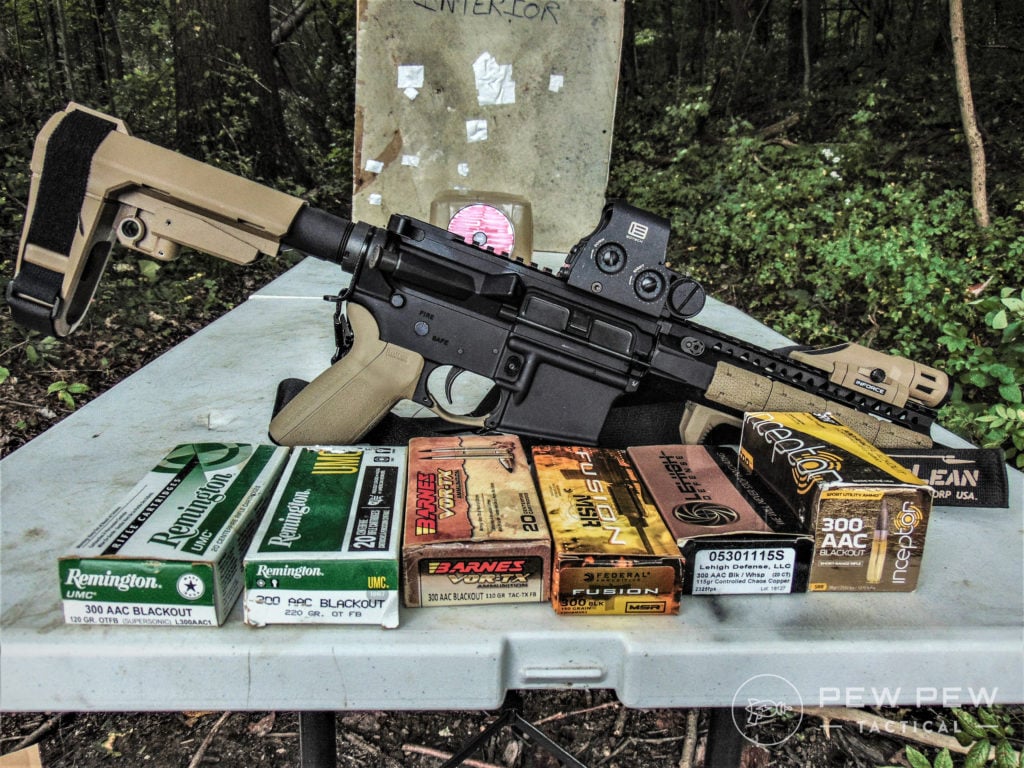
So, if you’ve ever caught yourself pondering the .300 BLK…keep reading.
Table of Contents
Loading…
.300 BLK History
The .300 BLK has its origins in the .300 Whisper, a round designed…as the name suggests…to be shot suppressed.
The case is formed by stretching out the case of a 5.56mm NATO and trimming it down slightly.
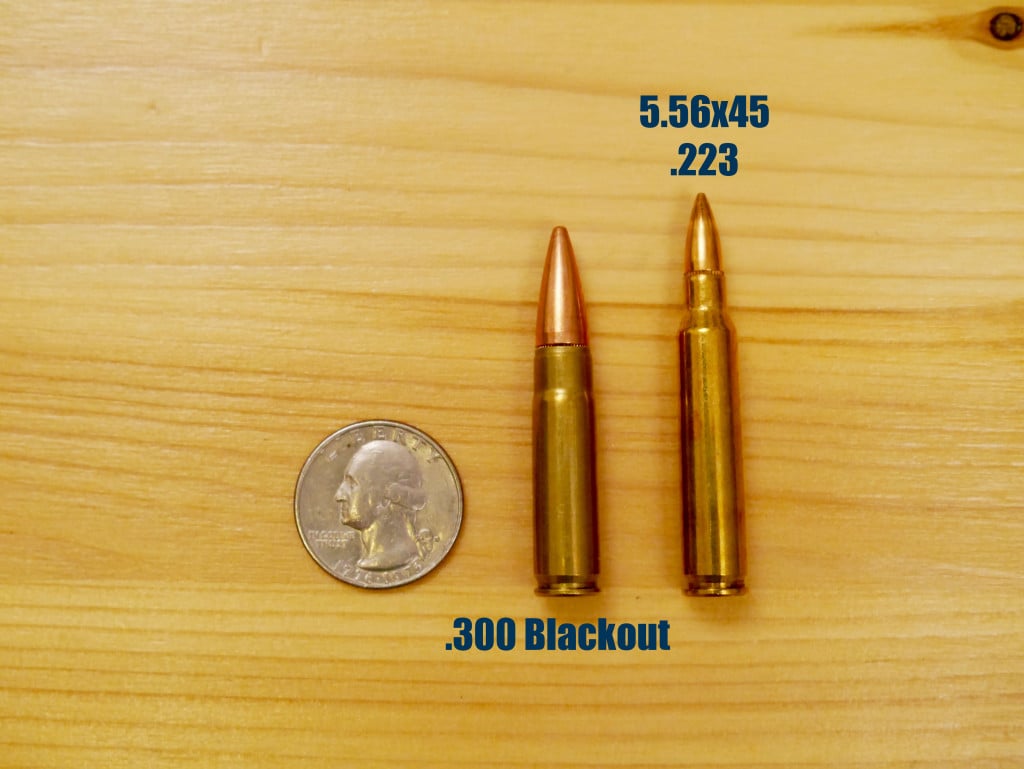
It is then stuffed with fast-burning powders and any number of bullets weighing from 110 to 220-grain.
Voila!
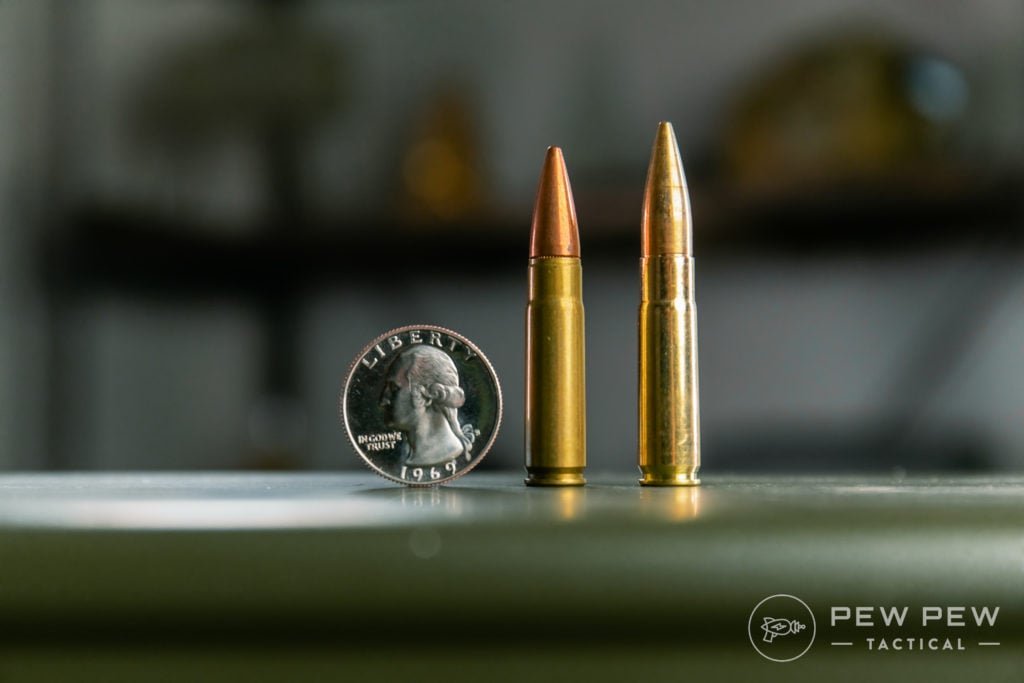
What you have now is the ultimate short-range thumper that will feed both supersonic and subsonic ammunition and get its full ballistic potential (complete burn of the powder) from a 9-inch barrel.
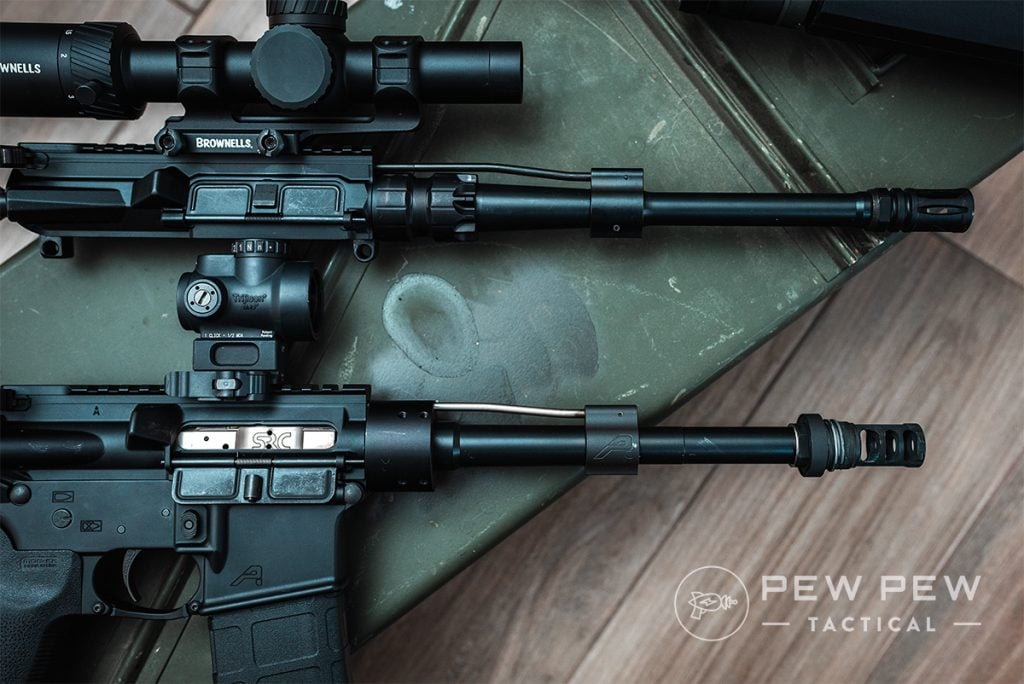
The .300 BLK is really what two long protracted wars in the Middle East have taught us about the modern gunfight.
You need a hard-hitting, short, light, and quiet, gun that will own 0 to 300 yards.
The AR-15/.300 BLK combo does this markedly better than the 5.56 NATO.
Why You May Want a .300 BLK Upper/Rifle
The .300 BLK has easily been the most successful new caliber in the last 20 years.
Besides the easy conversion between 5.56 and .300 BLK, the .300 BLK does a lot the 5.56 can’t.
First off, it’s a very versatile load with projectiles weights ranging from 110 grains to 220 grains.
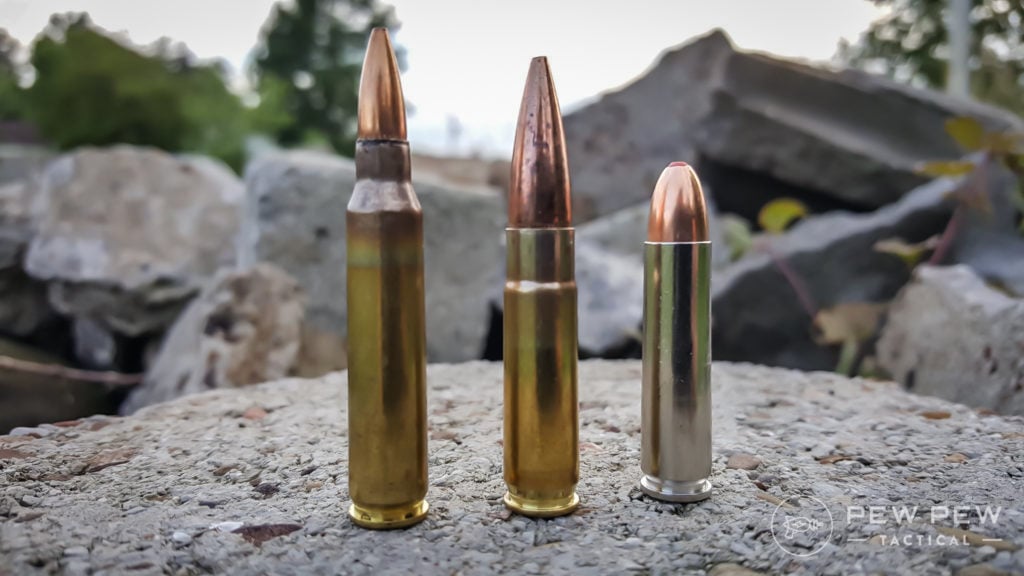
The 110-grain rounds are supersonic, and the 220 subsonic.
A subsonic round is much easier to suppress, and much quieter when suppressed. The .300 BLK also reaches peak ballistic potential from a 9-inch barrel.
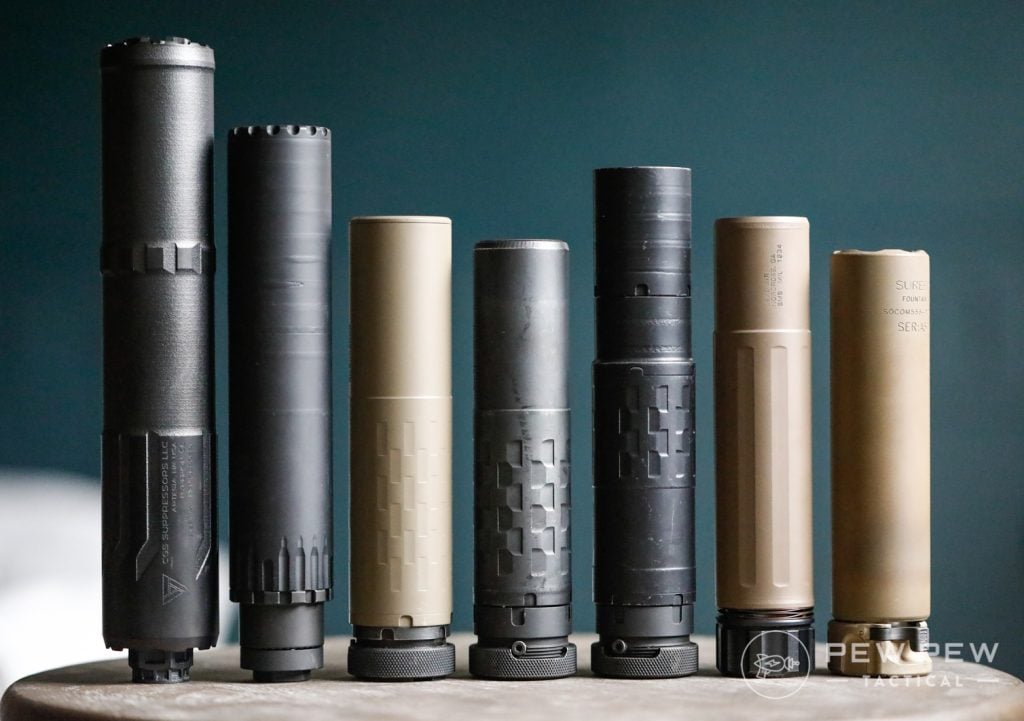
The 5.56 requires a 20-inch barrel to reach peak ballistic performance.
.300 Blackout vs. 5.56 NATO
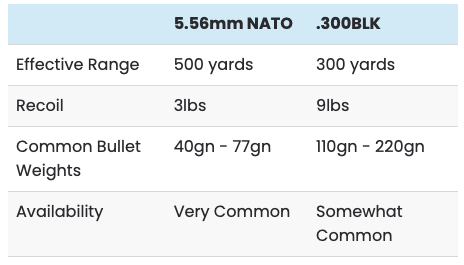
Strengths & Weaknesses
Both .300 BLK and 5.56 NATO are intermediate-class rifle cartridges for target shooting, hunting, home defense, and plinking.
The 5.56 is half the cost of 300 BLK and is available in more high-end loading suitable for precision rifle fire.
It also shoots flatter, experiences less recoil, and ammunition weighs about 40% less.
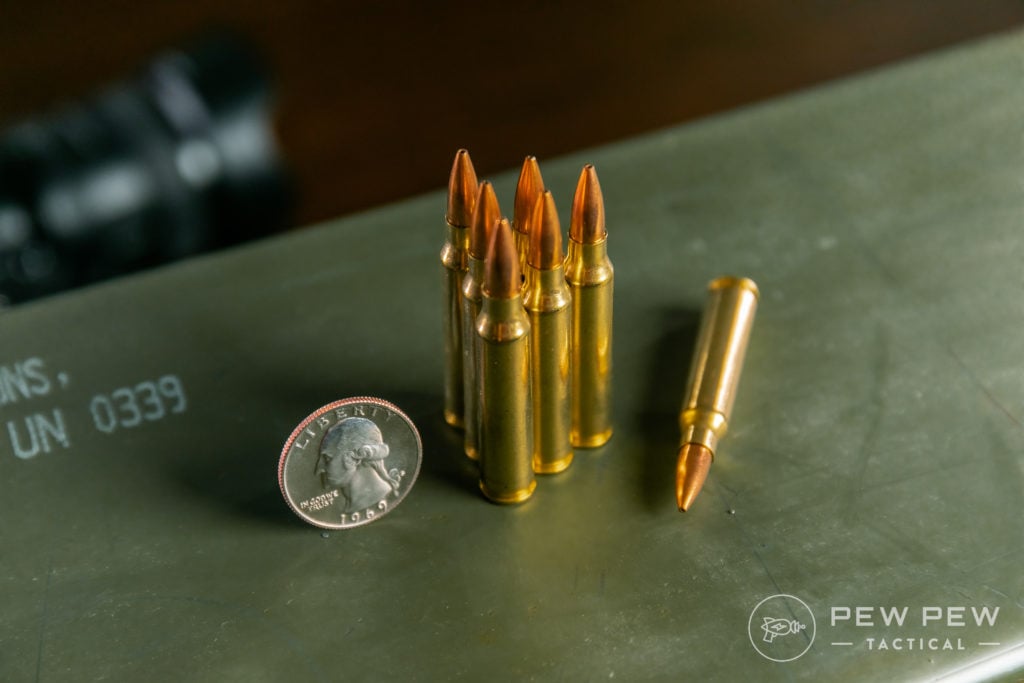
The .300 BLK offers a wider range of projectile choices, thanks to the .30 caliber bore, burns its full potential in a 9-inch barrel, and is a much better choice for hunting.
It also has the ability to cycle both super and subsonic ammunition without modification.
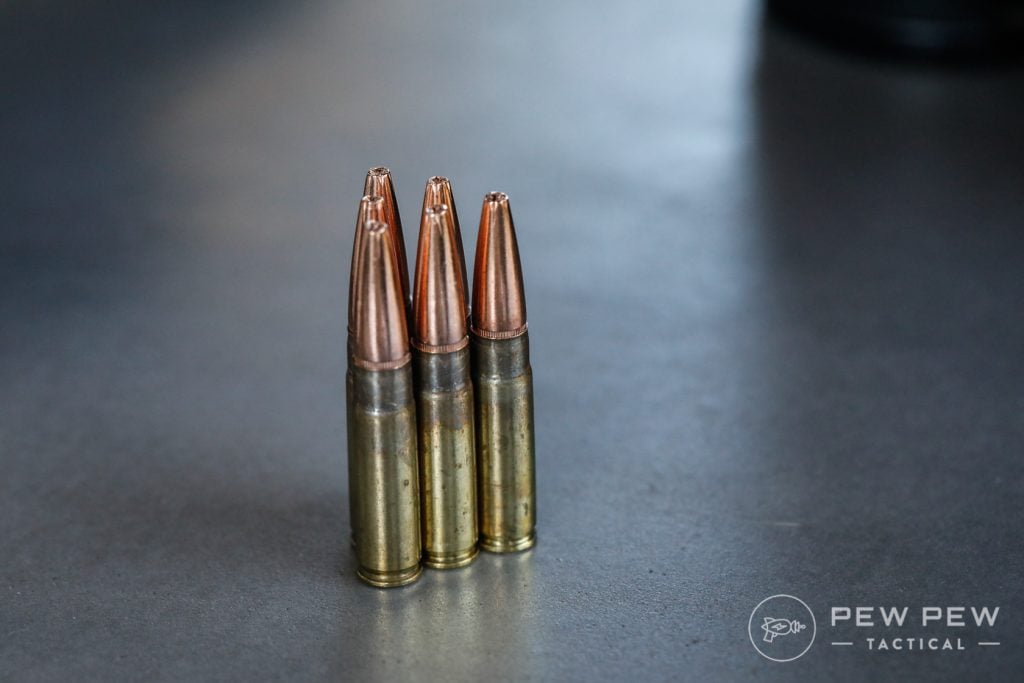
The .300 BLK also shows its strengths when short-barreled rifles and silencers are involved.
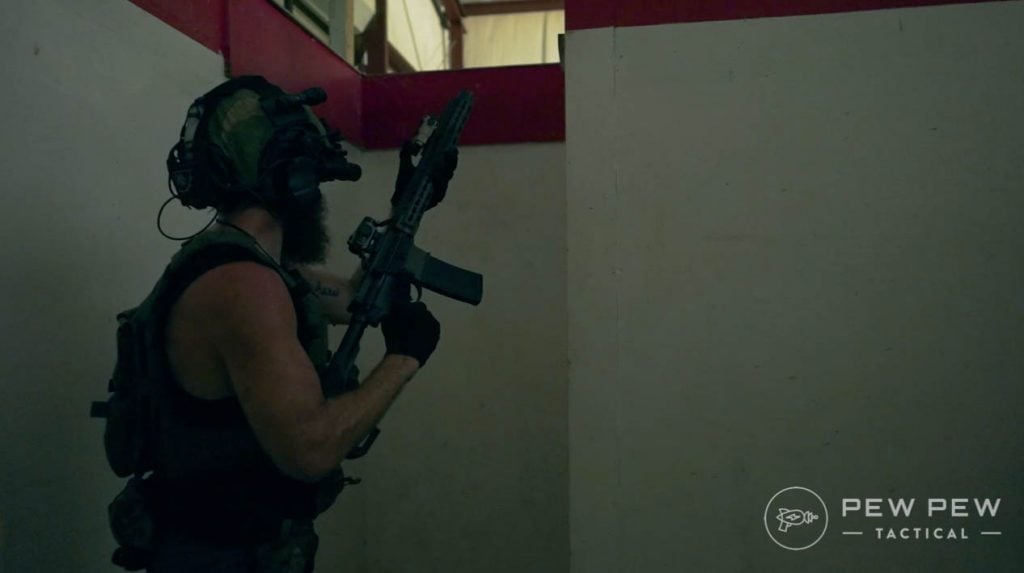
For a duty rifle that will conduct CQB work, this cartridge is a godsend.
Exterior & Terminal Ballistics
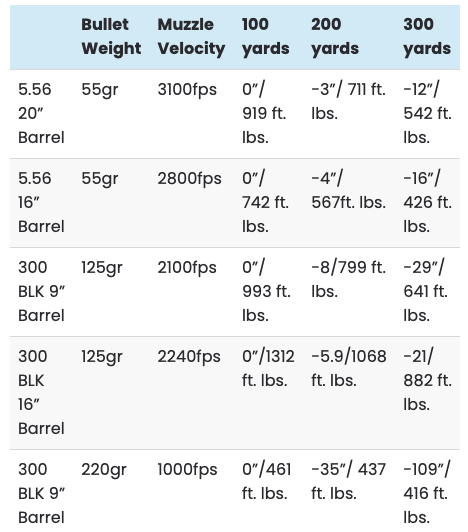
In the table above you can see the compared ballistics of both the .300 BLK and the 5.56 NATO.
It shows the barrels that the cartridges were designed around…20-inches for the 5.56, 9-inches for the .300 BLK, and the most popular civilian barrel length of 16-inches.
Exterior Ballistics
Exterior ballistics are the qualities associated with how a projectile flies through the air — wind drift, bullet drop, and zero range all fall into this category.
You can see above that the 5.56 is significantly flatter than the .300 BLK in flight. This is due to a faster velocity.
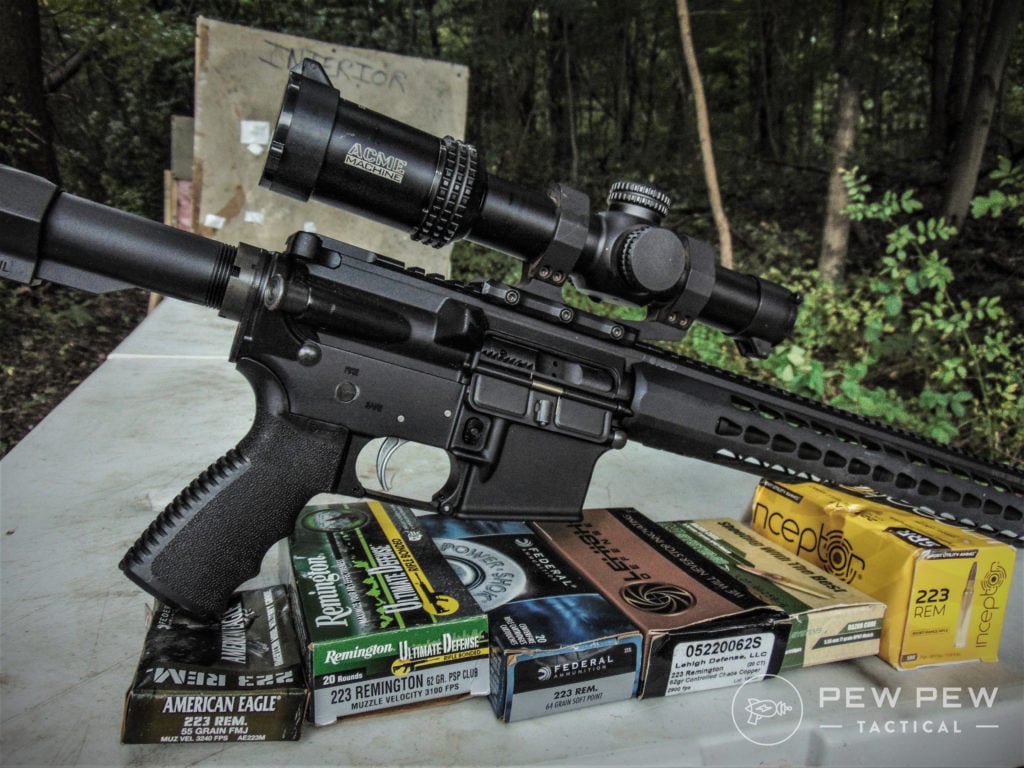
The .300 BLK uses bullets with a higher ballistic coefficient but isn’t moving fast enough to take advantage of its sleeker projectiles.
This is why the 5.56 shoots flatter and with less wind drift despite having almost half as much energy.
Terminal Ballistics
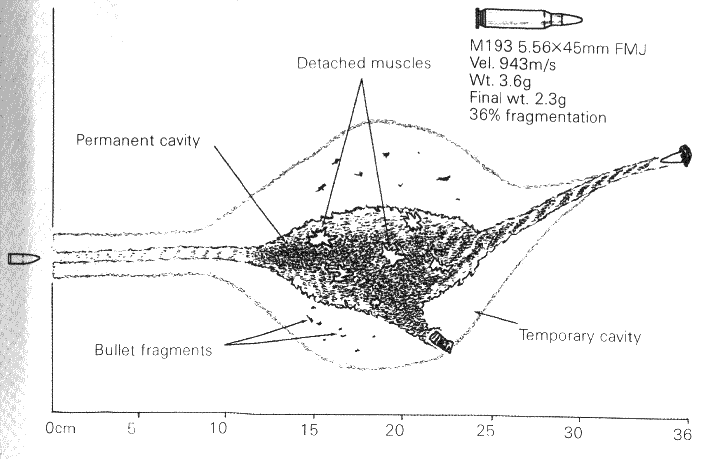
Terminal ballistics of a round are the qualities it has when it hits the target.
The round’s sectional density, the relationship of its mass and its weight, its ability to penetrate rather than fragment, and the wound channel it creates due to its bore size are all the study of terminal ballistics.
It’s important to note that while energy numbers can give you an idea of power, it’s only a single data point.
To the untrained observer, the .300 BLK seems to have the edge in terminal ballistics.
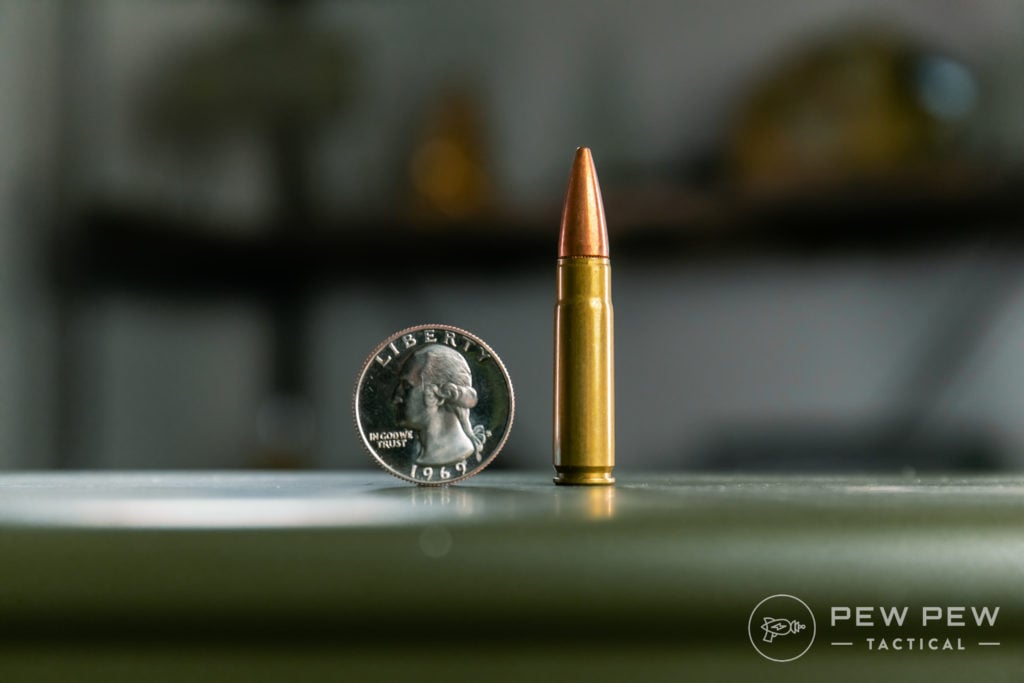
The stouter bullets, with more mass of a larger caliber, seem to be the more effective round.
While the .300 BLK does have slight obstacle defeating capabilities it isn’t markedly better in performance than the 5.56 with the correct loading.
Modern bullet design is closing the gap between calibers and making the smaller bores more and more effective.
Additionally, the 5.56mm NATO was designed to break up, tumble and flip end over end when it encounters a target.
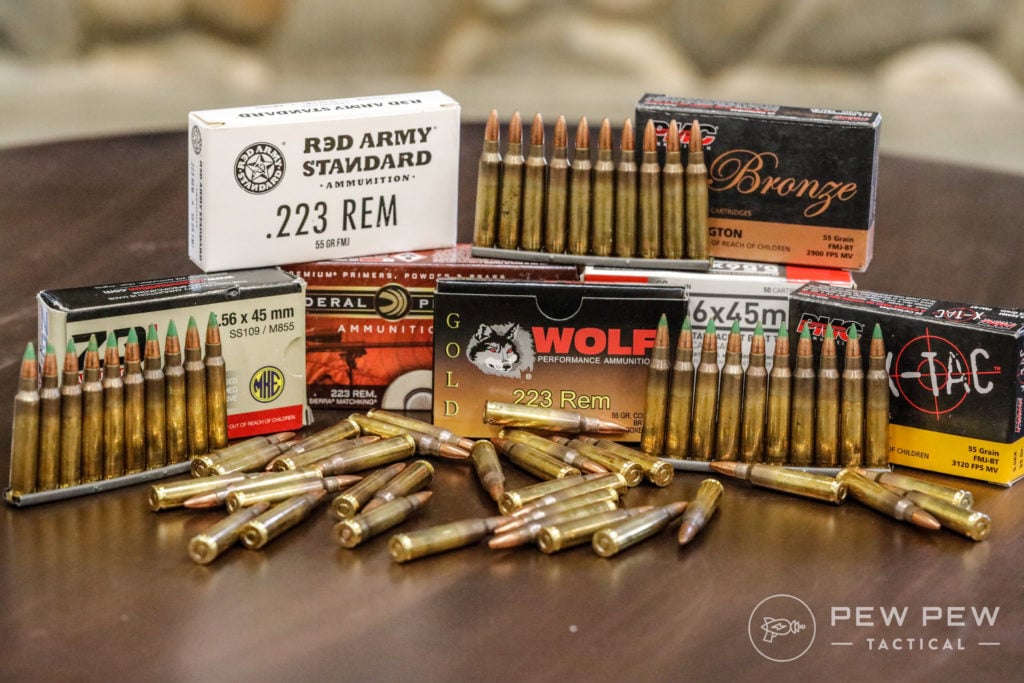
This is called high-velocity projectile fragmentation and deformation.
As far as a clear-cut winner goes…it entirely depends on what you want from the round.
General Shooting
Target shooting, training, or informal plinking, shooting is just plain fun.
It can get expensive so go with 5.56 NATO.
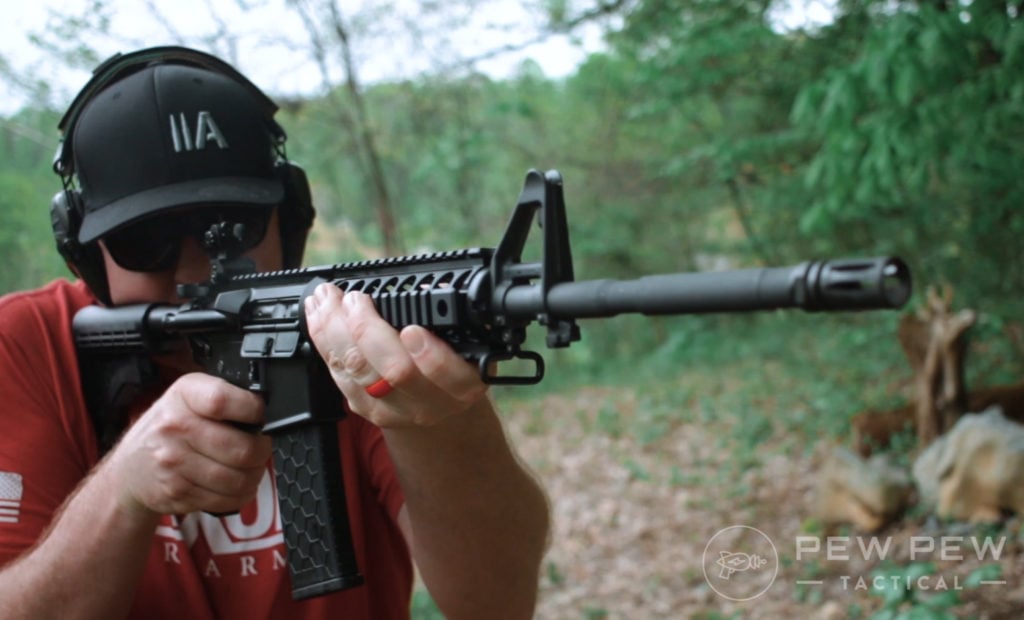
The .300 BLK’s benefits just aren’t needed when all you’re doing is punching paper.
Look for bulk cheap 5.56mm and use it. You can always switch to .300 BLK when the time comes.
Home Defense
Your home is your castle and for keeping the peace you should walk softly and carry a rifle.
.300 BLK and 5.56 both have their pros and cons and what’s best for one person, may not be the best for another.
The best selling point for .300 BLK is that it can be used with a suppressor and a short barrel — both of which are great for home defense.
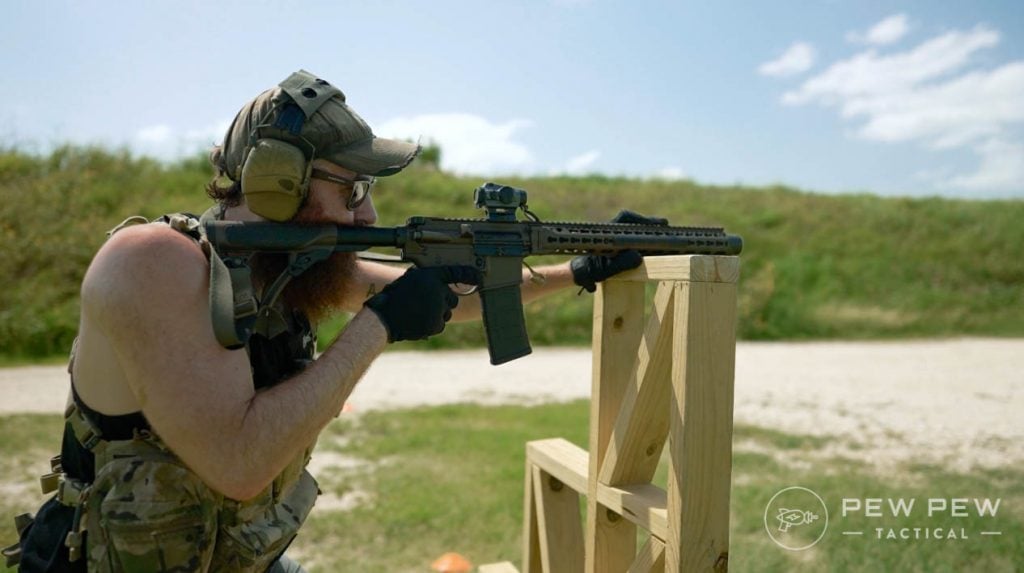
A short barrel makes it easier to move around your home and a suppressor protects you and your loved ones’ hearing.
That said, a major downside to .300 BLK in home defense is they have a lot of barrier penetration. Meaning that if you miss (or even if you do hit your target) there is a very good chance those rounds will carry through the wall.
Over penetration makes .300 BLK a very poor choice for anyone living in an apartment.

On the other hand, 5.56 has poor barrier penetration (it will still go through several layers of drywall, but loses effectiveness much faster than .300 BLK).
So it might be a better fit for apartment living.
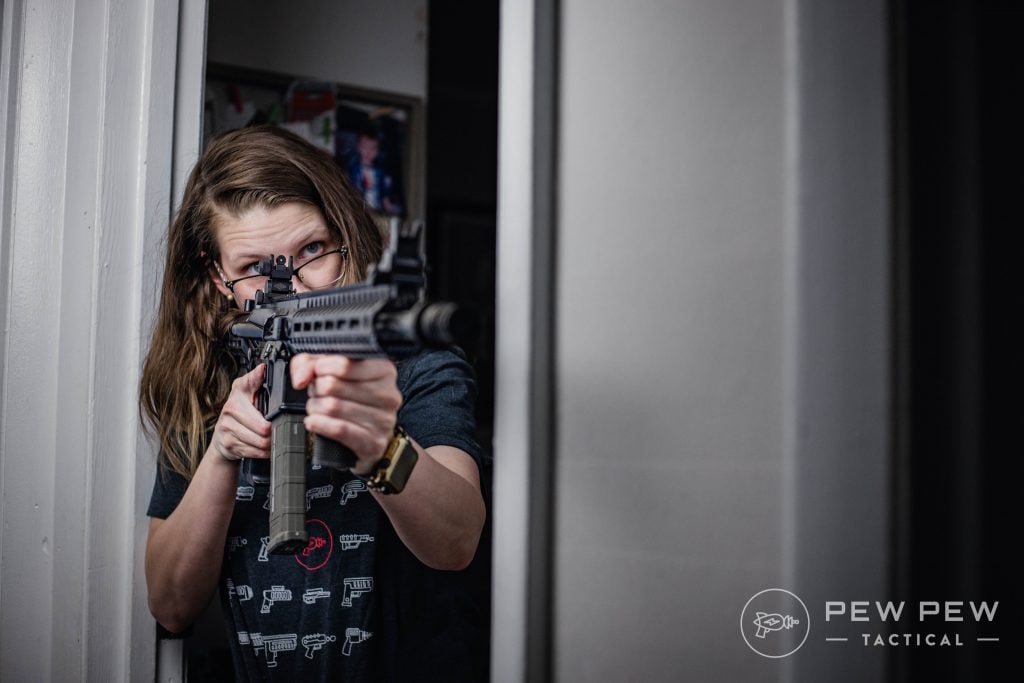
Hunting
With modern bullet designs, the gaps between the power of calibers are shrinking.
But what you’re hunting and the range are the primary factors when choosing a hunting round.

If your quarry will include only small game, predators, or mid-sized deer at ranges inside 100 to 150-yards then go for the 5.56.
If you plan on hunting medium or large game — such as deer, hogs, or smaller bears — the .300 BLK is far superior.
The extra mass gives more reliable penetration than the 5.56. And the typical hunting ranges of these animals mean that the slight disadvantage of the trajectory is negligible.
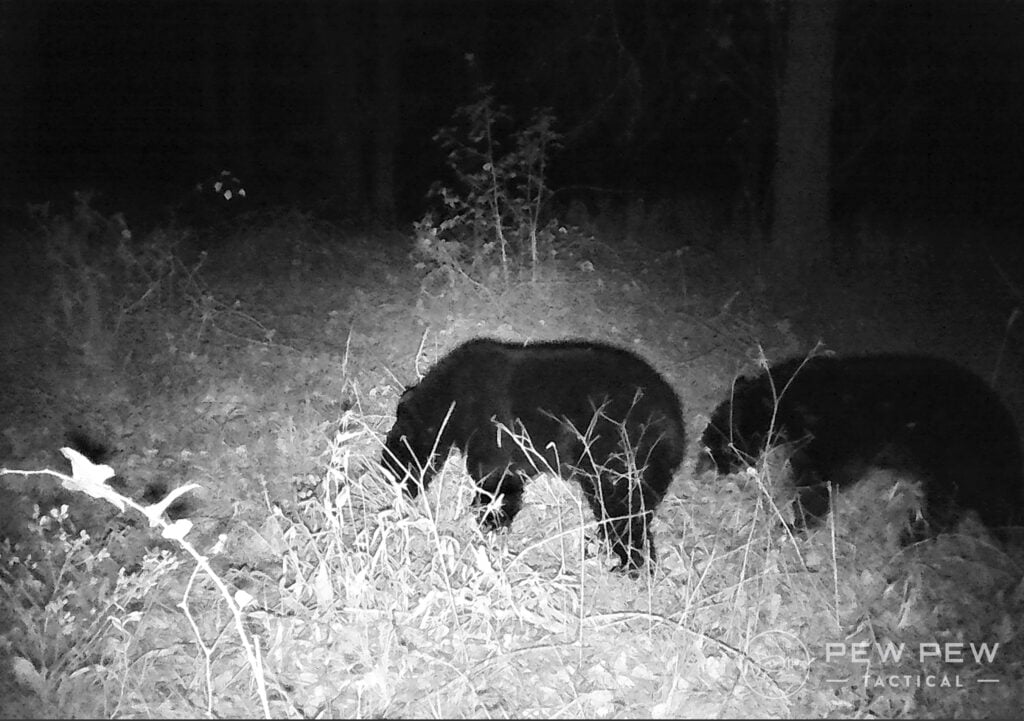
However, if you’re looking to hunt any game at distances greater than 150-yards or game larger than an above-average whitetail — you should look at cartridges with a little more oomph to ensure ethical kills.
SHTF
Shoot both!
Uppers available for cheap online can make your weapons much more versatile.
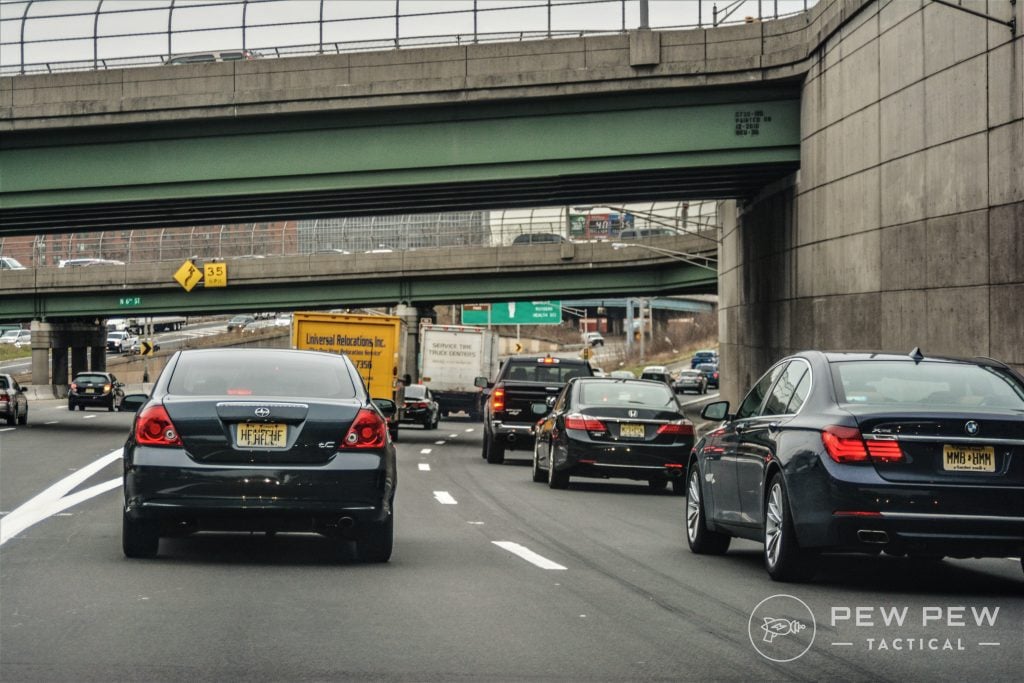
Because the .300 BLK is derived from the case of the 5.56, all you have to do to switch caliber is change the barrel. In an AR-15 the best way to do this is to get a second upper receiver.
Keep all your mags, high-quality bolt, lower receiver, and take advantage of both cartridges.
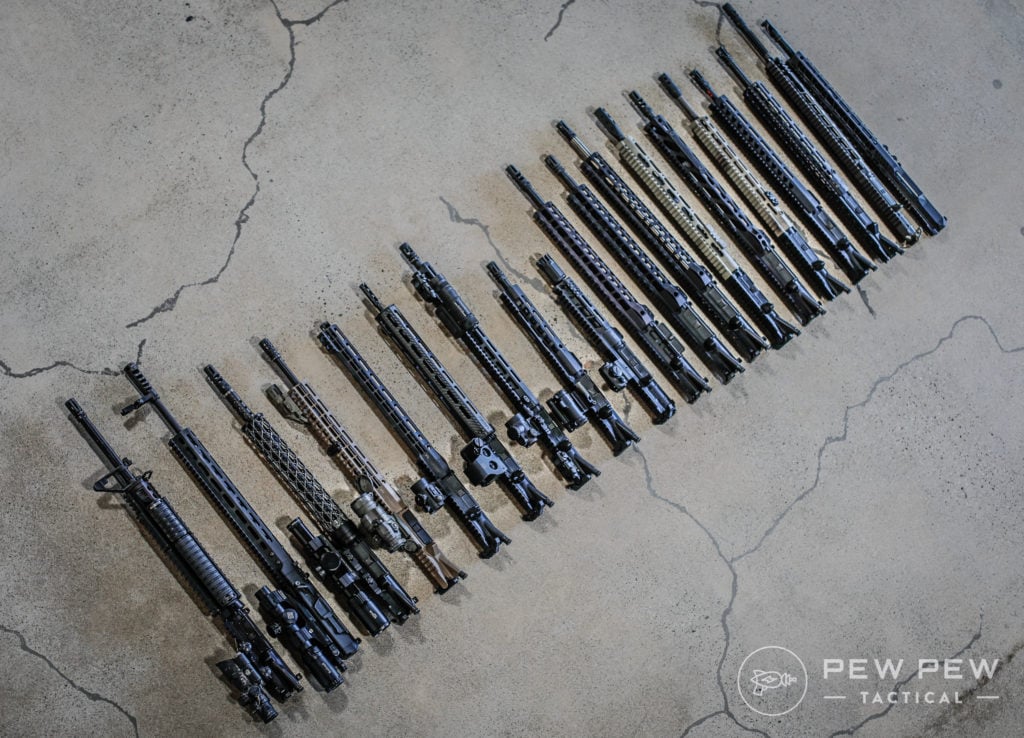
.300 Blackout Safety
I do want to note one thing before you run out and get a new .300 BLK upper…you NEED to be careful when switching between uppers or even when you have a dedicated .300 BLK rifle and a 5.56 rifle.
.300 BLK can chamber in most 5.56 barrels, however, if you try to shoot it – your barrel (and sometimes more) will literally burst. Explosively.

Make sure you keep ammo and mags separate.
Personally, I keep them organized by using different color mags — FDE and black for 5.56 and Olive Drab for .300 BLK. I also double and triple-check things before loading a mag into the rifle.
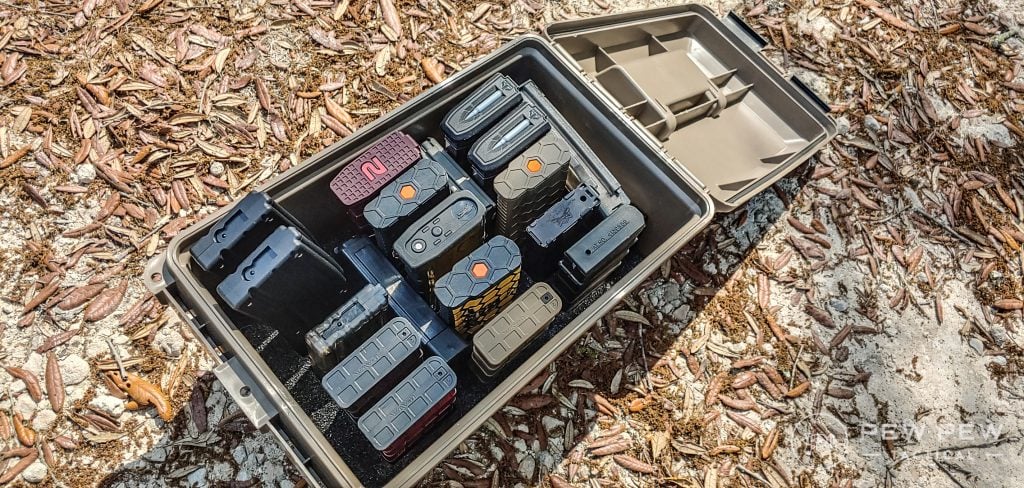
Conclusion
The .300 BLK won’t ever supplant the 5.56 for the most ubiquitous AR-15 cartridge but it does have some key areas where it really shines.
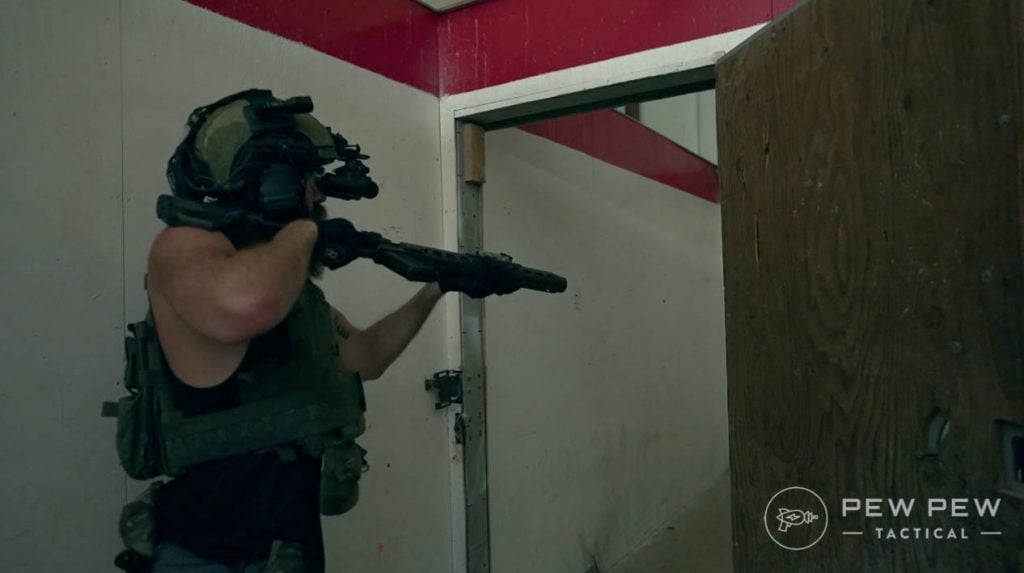
Most notably, it does great in CQB environments or alongside suppressors and can run on your existing AR-15 — so long as you get a .300 BLK upper.
In short, we love the versatility of this cartridge.
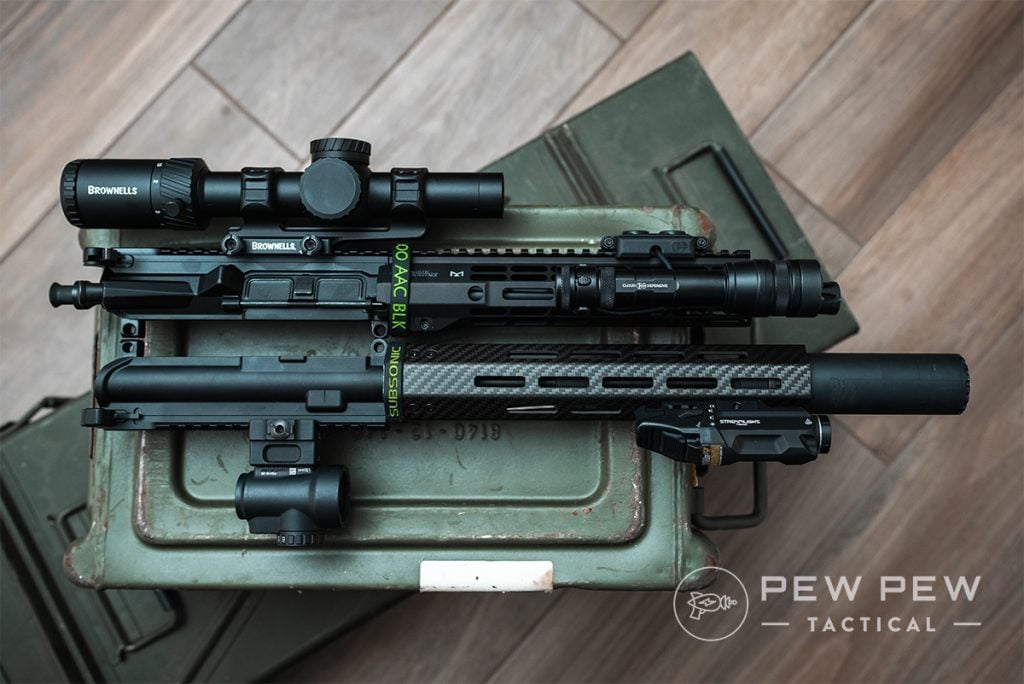
Does a .300 BLK make sense for you? We’ve got a lot more where this came from!

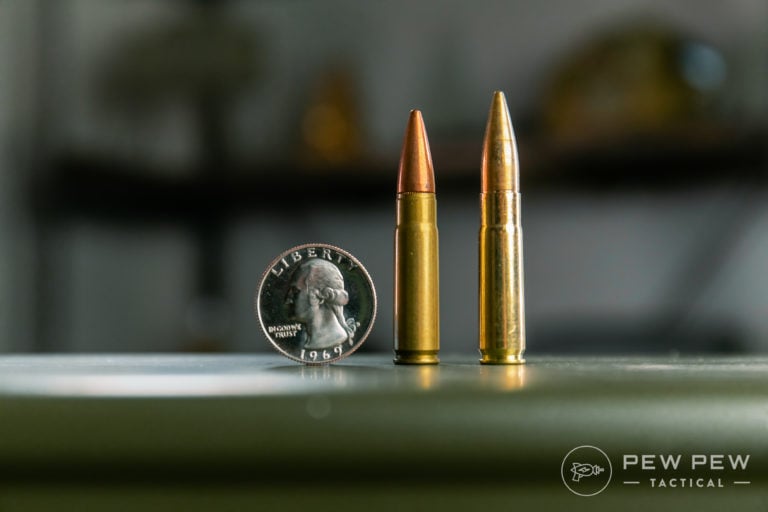







82 Leave a Reply
GREAT read! And thanks SOO much for the info. on the breach/chamber compatibility of both rounds and what happens when a 300 BLK forces it's big foot into a .223/5.56 bedroom slipper.
.300 BLK is taking a 5.56-centric platform and mutating it into a mediocre subgun with neither the advantages of 9mm or 5.56. It's tailored for fantasy situations straight out of video games.
You're not going to be toggling sub and supersonic ammo in the field because that introduces complications with both your zero and your reliability. Even with both of these factors ironed out, you're going to have to dedicate a portion of your load to one use or the other. In a scenario where things are so bad off that you need to fire at targets 300m away you're going to be working with a handicap to your capacity and at that point it just makes more sense to run 125s, and now you have a supersonic platform 100% of the time. You're back to where you started.
For me, the benefits of 300 BLK come with hunting in a shotgun/pistol only zone. Supersonic 110gr hunting rounds are extremely effective at typical whitetail distance out of a pistol length AR. That said, if I could use a rifle, I would probably look for another caliber - possibly only as an excuse to fill the gun safe further.
I have a Plumb Crazy AR-15. Will the 300 blk be safe in this weapon?
I've had a Bushmaster 10.3" AR15 in .223/5.56 for 25 years. Thankfully never had to use it in self defense, which is the only reason I bought it. Now I'm waiting for the delivery of a DDM4 PDW but don't plan to ever fire it, as silly as that sounds. If i have to fire it, it will be in self defense. I envy all you guys that live in free States. If suppressors were legal in my country, I'd buy one and have fun with subsonics in my virgin PDW. Rather, I'll buy the hottest supersonic BLK ammo I can find and refresh it frequently. I will keep practicing with my SBR with .223/5.56 and .22LR ammo for the rest of my life.
"Stretching out the case of a 5.56, then trimming it to .300 specs?" This comment makes no sense, unless the author is describing "stretching out" as increasing the diameter of the case, and trimming the case down as to be able to fit the larger-diameter bullet. What about replacing the action that is required to acommodate the fatter case, and a new barrel to acommodate the fatter bullet? I'm a long-time reloader, I'm confused as to the description of the supposed "easy" reloading process that is supposed to handle the new case size. Did I misread the article, or is it just due to the "aging" process?
The diameter of the "body" and base of the case isn't increased, hence why you can use the same BCG and action. The neck diameter is "stretched" or increased to accommodate the 30 cal bullet. This necessitates the need to be very careful not to accidentally load 300 aac into gun with the 5.56 barrel. The 300 aac will fit in the action, and because it is shorter, the action will close and the trigger can be pulled. The 30 cal bullet acts as a plug in the smaller diameter barrel and the faster burning powder of the 300 aac will cause catastrophic failure, EVERY TIME. The confusion is understandable, because the diameter of the bullet is considerably bigger.
Shhhhhhh...
Solid work Pike.
Good to see you doing well.
2/2 Easy Company Warlords!
.300 Black out or 5.56, which AR-15 is easier to clean?
Enjoyed the read, very informative. Reaffirmed my decision.
Which AR-15 carbine is more reliable, 5.56 or .300 AAC Blackout? Thank you in advance.
Since I can't post a comment I will unsub.
Hey Bryan, we're having some issues with comments popping up as errors but they are actually going through! Hang tight as we get this worked out!
There are 85 gr bullets too!
2550fps. I have some in penetrator style and some in TREX. The rapid expanding type.
A lot has been written about the 300 BLK, however not much has been discussed regarding optics for subsonic loads. I would think that after all this time, manufacturers would develop an optic with bullet drop compensation. Does anyone know if anything is available.
This is a Great! comparison & contrast of the two calibers, plus the inclusion of everything a 2nd Amendment owner wants and/or needs. Well done! And combined with the interactive research links it should be a must-read for anyone anyone wanting to own either caliber.
Thanks for the great article! After my son talked me out of building a 300 BO pistol he went ahead and built one for himself. Unfortunately he bought the wrong size barrel so after some dealing I ended up with it. I bought the other pieces for the upper ( Built a 5.56) and having my ffl neighbor put it together. Trying to decide on whether to suppress with all the paperwork involved.
Ordered a suppressed 300 upper from suppressed weapon systems. Build just completed, being shipped, then the dreaded ATF wait… excited though!
BCM ARs are sweet rifles. My BCM is 300 Blackout and my Stoner is 5.56
Love the extensive analysis.
Ruger American...? I think the Ruger Mini-14 Ranch Rifle is a much better choice, especially in states where ARs are subject to the "featureless" restrictions. I mean I suppose you could shoot 300 BLK out of a bolt action, but why? The whole raison d'etre for 300 AAC is to shoot it out of a compact semiauto platform, suppressed where available. If ARs are restricted in your area, a Mini-14 is probably your next best choice.
So that you won’t hear any action noise
I enjoyed the articles information, I learned a quite a bit.
Great article!
I bought a .300 Blackout upper after hunting whitetail deer with my 5.56 rifle. I wasn’t able to drop a medium sized deer with the .223 ammo I was using and decided not use that caliber again for whitetails. After a year switching my uppers with my lower, I decided to build a lower and now I have a dedicated .300 Blackout deer slayer with a 4x illuminated scope. I use Winchester Deer Season XP 125 gr ammo which is an excellent deer round in .30 caliber. I also use a 10 rd Magpul magazine so I don’t look like I’m going out on a search and destroy mission. Now, I’m very happy with my Colt M4 in 5.56 for home defense and my .300 Blackout Anderson AM15 rifle for Whitetail deer hunting.
Typically we see that the 300blk can use standard AR15 5.56nato magazines. From a discussion on that topic I had with a young lad who is a Gulf War vet who shared that the typical 5.56nato mag has a spring that is too weak to work reliably with the heavier 300blk rounds. There is also come thought the brass forming differences can cause occasional feeding issues. I
I have a Ruger 556 pistol in 300blk in layaway so I will be spending some time putting the list of must haves before I pick it up. MagPul magazines have always been my first choice and they make a 30 round 300blk magazine in black only. I am hoping they come out with the 20 round versions since I use them in my 5.56nato AR pistol. The 30 round versions are fine most times except when shooting prone.
The whole complete burn in 9" was marketing hype and generally only applies to subsonic ammo. That said, supersonic .300 BLK is a decent cqb upgrade.
However, I find 6.8 SPC to be more interesting. Suppresses decently with 30 cal cans and has much better ballistics. Accuracy tends to be better as well; several companies refuse to offer .300 BLK barrels because they can't maintain their usual accuracy guarantee.
Another big advantage for the 300 AAC appears to be in AR15 pistols. The ability to carry an AR in a backpack or in the car “hot” providing it is legal (CCW) is a real plus.
What does the writer mean/specify when he says "First on the list is that to fully burn the 5.56mm NATO powder charge requires at least 12″ of barrel – without those 12″ you’ll get a massive fireball as the round leaves the barrel with every shot as the unburned"? I was looking at AR pistols with sub 12-inch barrels and just wanted some clarification on how there are AR pistols with barrels less than 12 inches, does it have to do with the AR's gas system? Someone enlighten me.
Powder needs a set amount of barrel length to have enough time to fully burn and combust, for 5.56 that length is 7- to 12-inches (roughly). Without that amount of length/time to burn, some unburnt power will escape with the bullet and combust mid-air thus making the big fireball.
AR-15s can be made with shorter barrels since, strictly speaking, you don't actually need the powder to fully burn for the rifle to work. You'll get a fireball and excessive gas, but it will still function. Sometimes the benefits of a short barrel outweigh the negatives of a fireball.
Shorter barrels have other problems though such as the increased gas pressure putting more wear and tear on the gas port and BCG.
At this point there is only 1 commercial offering for 5.56nato that is for SBRs. That is the Hornady Black in 5.56nato 75gr interlock. They run about a buck a pop, but do not have the muzzle blast or flash of typical rifle leadings. This round is optimized for 9.5” to 12.5” SBRs. Mine is a 10.5” Ruger 556.
I had a AR pistol with 7.5” barrel that was a beast of blast and flash. Damned thing would beat me up in an indoor shooting booth.
Actually you can usually find the 75gr Hornady Black HD SBR for around 75 cents/round...closer to 60 if in bulk (when you can find). Have been running on my 10.5" SBR with an A1 cage and Thordsen deflector. No...zero...flash, even on rapid fire, and the deflector pushing the blast down range diminishes the usual punishment significantly. Round is designed for SBR/pistol application with full burn within 10.5" so it's been a winner for my application. Whether HD/SD or decent sized game, this has been a proven performer with nearly 900 ft/lbs at the muzzle, 650 at 100 yds.
I can attest to this. My friend owns an AR pistol, and shooting it makes my eyes water. The excess gas so close to the shooter is definitely a thing. Especially with a muzzle brake that directs gas to the sides and toward the shooter. Either I'm sensitive to it, or others simply don't care about the downsides. Maybe both.
Does your votes for best 300 upper include pistons since they would be quieter?
If 300 blackout has 2x the power of 5.56 @300m, why is 5.56 better at lang ranges? You're talking more killing power at longer ranges. Despite an extra 3" of drop-arguably negligable.
300 yards is commonly considered the max effective range of 300blk. After that range, it starts to drop like a rock. With a 100 yard zero at 350y it reaches almost 40" of drop, at 450y it's around 75", and at 500y it is over 100" of drop. Trying to hold over 8 feet above your target is hard enough, let alone the anemic energy 300blk will have on target at that range.
5.56, on the other hand, will only suffer 56" of drop at 500 yards.
While 300blk is a great cartridge inside of 300 yards, 5.56 can be pushed much further.
The .300BLK has around 20" drop with roughly 900 ft-lbs energy at 300 with a standard 110-130 grain hunting load.
The 5.56 has around 10-11" drop at 300 yards with 420 ft-lbs of energy with a standard 55gr multipurpose load.
The facts are abundantly clear, for a combat/protection caliber under 300 yards... in the hands of someone who can utilize the tool to it's maximum effectiveness... the .300BLK is a superior round with more utilization capabilities than the 5.56.
It's like comparing 30-06 to .308. Under 500 yards, the 30-06 just HITS harder... but after the 500 yards mark, the .308 excels.
The question then becomes, how many of us can effectively hit anything at that range, and the answer is not most.
Under 300 yards, .300 BLK beats everything as a cartridge with many capabilities.
Over 300 yards, in any application, military/law enf/hunting... you want a magnum. Don't kid yourself.
Before anyone refutes my 30-06 analogy data, G. Sgt Carlos Norman Hathcock killed an NVA general at 800+ yards with a heartshot. He wrote the STA Platoon scout/sniper handbook. It's not easy to recreate those shots. To hit targets at that distance you need real skill. It can be done, I have done it, but you really are kidding yourself if you think a green shooter can pick up any gun and hit things at 500 yards. An AR loses this match up.
You're all over the place here, so I'll educate you a little bit. First, the .308 doesn'tbeat the .30-'06 at anything ballistically. It is perhaps a more accurate cartridge, but that varies widely and depends more on the gun, shooter than anything else. Shooting the same bullet, the '06 will outpace the .308 by 300-500fps, so it will be evenore effective past 500yard than the .308. As well, according to GySgt Hathcock, the shot was around 750 yds, and was done with a .30-06. You sound like one of those newbs that has bought in to the .300 hype. It is a great cartridge with tons of versatility but ballistics isn't one of its strong suits. At best its a 200yd cartridge, mostly due to the fact that most .30 bullets won't expand at the lower velocity of the BO.
They will be more likely to make hits at 300-600 with a 223 than with a 300 BLK since the BLK has a useless trajectory (compared to most other modern CF rifle rounds) past 150-200. The 6.5 Grendal in the AR platform out performs BLK in all regards for everything but sub-sonic use with a can..
You are completely backwards on the 30-06/308 comparison. The 308 was designed to duplicate 30-06 M2 ball ammo and it will do this. With bullets over 150 gr its increasingly inferior and requires long barrels and 155 +- gr low drag bullets to keep bullets stable (comfortably super sonic) at 1000 yards. Its OK with 168s to 600 but thats about it from standard length barrels. The 30-06 will shoot 173-180 match bullets to 1000 from 24" barrels no sweat since it can move them significantly faster and they are more efficient ballistically. Remember with its case capacity some modern factory loads are equal to the original 300 H&H loads. Look to the 308s used in Palma matches. Barrels are around 30". They load them hot as well. 300BLK is a special purpose round of limited usefulness. BTW Hathcock was using a 30-06 to shoot the NVA General IIRC, not a 308. Just saying... Also the rifle he used most was about a 2MOA rifle according the Land his CO. But it was the only rifle they had that held zero the others changed with wet or dry conditions. You need to do more research.
Shoot 77 gr bullets from the 223/5.56. My 77gr BTHP match handloads carry 780 fp at 300 from a 20". Hornady factory 75 gr BTHP black rifle loads or match are about the same. My 16" will produce over 680 at 300 with my 70 gr GMX handloads and is a great "short range" deer rifle with 100 yard zero its only 8" low at 300. These are as accurate or more accurate (my 77 gr handloads from my AR15 match service rifle are 1" or less at 200 for 5-10 shots) and shoot flatter. The 300 BLK is a special purpose round of limited usefulness in the real world. The 6.5 Grendal is far superior to the 300 BLK for hunting. But people think the 300 BLK is cool and somehow "cool" makes it better. Its only better for sub-sonic and with heavy sub-sonic loads its more likely to over penetrate and/or ricochet.
This is .556 fanboy talk, and I'm one of them so I should know. The .300 blackout out of an equal length barrel is far superior inside 150 yards as the bullet drop is negligible and the round is larger (more material to expand), less gasey, less muzzle climb (added felt recoil) quieter suppressed or not, MUCH more powerful, and can reliably cycle subs and supers out of a much shorter barrel with power equal to .556 in longer barrels. The "over penetration" belief is not true. There are plenty of rounds that have less penetration than .556 with lower velocity thresholds especially in shorter barrels since once a .556 drops under 2,500 fps (which it does very quickly, and does right out of the barrel in 10.5) it begins to lose its frag and tumble capabilities, causing deep penetration. Even out of a 20 inch barrel the velocity will drop below that threshold inside 150-175 yards. Check out Lehigh defense CQB .300 (has no more than 15 in penetration and frags much larger chunks than .556 with a very low velocity threshold) among others and that argument is toast. That's a plus, since if you want penetration you can have it or not you just choose the specific round for the job. The Grendel gives up it's subsonic capabilities and it's interchangeability with the .556, which is one of the main points of the BLK. It also wears more on the barrel, is louder, VERY expensive to shoot, limited loadings, and there are other rounds that are far superior if you're only intersested in hunting or power, all for a couple hundred extra ft lbs. THAT is a round with limited usefulness. Subsonic rounds in BLK are not useless either, if your goal is very quiet, low to no flash, and pistol carbine recoil. A well placed shot at 50 yards and in will do the job nicely and shoots plenty flat at that distance. The .556 as mentioned in the article has its benefits (lighter, flatter, cheaper, more available) so it depends on what you're doing, but the BLK has more than limited usefulness.
This article seems to be almost word-for-word an article in the American Shooting journal, but I don't see your name on that. Did somebody plagiarize somebody else?
Thank you for alerting us, it looks like they've posted a bunch of our articles. I'm counting almost a dozen so far.
First off, there is no "explosion" with smokeless powder, it burns at a controlled rate. The hot flaming gasses are traveling at the same speed or slightly faster than the projectile, when they hit the still air at the muzzle, the collision causes the bang. A suppressor does not "handle the explosion", it gives the gasses a place to expand and slow down to subsonic speeds. The next point is if you can't make an "ethical" shot on a game animal with subsonic ammunition, then why would you consider it for combat? Doesn't make any sense. An enemy combatant that escapes can shoot at you again. All of this is basic physics, there is no magic when it comes to how gasses or projectiles act. No projectile/case option is ideal, they all have pluses and minuses and are a compromise in some way. If you need to shoot a .30 cal then an AR-10 in .308 is the way to go with the trade off of more recoil and heavier ammunition.
Or... why would you care if an enemy combatant writhes in pain before they die?
It seems, Blake, that you've never been in a position to have to kill anyone. Warfare is about ending the fight as quickly as possible, not inducing as much pain and suffering as possible, aside from the fact that while your enemy is writhing, he may also be firing back at you. Your comment gives a bad name to the pro-2A crowd. We're not about killing- we're about preserving life. In combat we kill not because we want to but because we have to.
This is something we need to think about in general within the pro-2A community- the way we talk and the words we use can affect how the anti-gunners perceive our precious 2A.
Many rounds that are effective on humans are not ethical on game animals.
lol like most you have no idea on the 300BLK origins. It’s a 221 Fireball necked up. A 5.56 stretched and the 5.56 is much longer to begin with?
nvm, ignore please
"...who can think of a time where you wish your AR-15 had a little more juice?" All 3 tours in the sandbox. Once I got an EBR in 7..62 Nato I no longer felt that way.
Someone here is vastly overhyping the 300 AAC Blackout, The 223/5.56 is superior for the following reasons:
1) 223/5.56 ammo is much more readily available and is 1/3 the price of 300 AAC Blackout, both important in a SHTF environment.
2) recoil from the 223/5.56 is less than half the recoil of the 300 Blackout which is important for follow up shots and in reducing flinch.
3) the effective kill range is greater for the 223/5.56
4) 223/5.56 ammo is lighter to carry
He made all of those points, and I don't think he was hyping anything.
1.) I reload and have invested heavily in this new tech so have over 100,000 rounds easy
2.) I suppress, feels like a 22 and when I don’t, I’m 6’2” and 200 so still...22
3.) 308...
4.) I hike 3-4 times a week with a 50lb sand bag
Did you even read the article? Or were you too busy fondling your 5.56?
I am under the impression that actually M193 is the better armor penetrator, as the key to defeating armor is speed and angle of impact, and it is a fast, flat-shooting round. I thought M855 was designed to defeat barriers such as glass or cover, but not body armor per-se (though I do think I read something about it having to prove to be able to penetrate a steel Soviet helmet). Of course, modern ceramic hard plates would not have been a consideration on the battlefields of the cold war, so perhaps it is just a lucky accident that this common round had so much velocity and therefore proves to be an excellent hard plate penetrator, even in its lead core form.
You're correct, M193 is a better armor penetrator than 855...at least according to our tests with AR500 based armor. It's mainly the speed.
Good, balanced review. I don't see the 300 Blackout replacing the 5.56 as a military round because of its weight and short range. As a home defense, police, or light/medium game hunting cartridge, it has potential, provided the operator uses the proper load for each scenario. My rule of thumb is to consider it as a potential pistol carbine or 7.62 AK alternative.
If the 220gr subsonic suppressed 300 Blackout round in a 9 inch barrel fired from an AR platform was specifically designed to replace the 124gr subsonic 9mm MP5SD for CQB operations, then that is the only fair comparison.
Any other operational or civilian application comparison (outside of home defense) is invalid..
Invalid is the wrong word. A full power 300 blk load is worlds away from 124gr 9mm. So to ignore that or consider its existence invalid makes no sense.
Agreed. I was wondering at what point did someone start stretching the .300 AAC past its original design parameters. Two totally different rounds designed for totally different reasons.
Harkens back to the old M1 Carbine round being called "anemic" as a frontline round when it was never designed or intended to be used as such.
No disrespect to the article here intended.
I agree 100%. Outside of home defense or clearing houses suppressed, you are exactly correct. Use a weapon as it was intended, mission specific.
I totally disagree with the comments about this round not being accurate. I shoot both super/sub sonic suppressed/un-suppressed, and have sub moa with all. My upper has 7/1 twist, and I run an ATI scope, which has all 4 combinations programmed into it. The scop is a Little overkill, but I really love the night vision. Deer have never gone more than 25 yards before dropping using subsonic suppressed ammo.
Actually, @68 degrees, and sea level, the speed of sound is 1,125fps.
Break a bolt lug, blow an extractor, or bulge the barrel on your Mini-14 and get back to me on the superior action part. The Mini might be more rugged when used as a bat or stick to mount a bayonet on, but it is certainly less durable when subjected to actual shooting. The Mini-14 (and AC556) has been tested multiple times by US and foreign military agencies It was always found lacking in durability, and field maintenance. You can’t buy a spare bolt without sending to Ruger for fitting. Forget extra barrels either. ARs have their issues, but they are (at least in Colt/Tier 1 manufacturers) military grade weapons. The Mini is not.
Get 2 mini14s in 5.56 and .300. More reliable, dont foul up, fir an adjustable gas port to the .300 if you want to shoot sub-sonic.
Thats a big fat NO! The mini’s are not as accurate or durable!! The AR-15 speaks for itself being fielded in the 50’s and still used today!!! Please sir get your head outta your arse!!!!
Or get 2 Mini14s in 5.56 & .300. Same mags, better action, less fouling, more reliable and fit an adjustable gas port on the 300 for subsonic
I would really like to see a head to head comparison in pistol AR platform. As the .300 was designed for 9" barrel, and 5.56 20", it is my educated guess that .300 wins without any question.
https://www.gunsamerica.com/blog/gunfight-science-5-56-nato-dumb/
"Additionally, the 5.56NATO was designed to break up, tumble and flip end over end when it encounters a target."
I would argue that this was the case for the NATO M193 (55gr), but is not so much the case for the M855 (62gr) "Green Tip" penetrator round. The ballistics on the 62gr are better, but the steel penetrator core means that while it will penetrate barriers (wood, glass, vehicles, etc) better it will OVER penetrate people... often leaving a "through and through" GSW with little to no yaw (or tumbling) that creates a wider wounding cavity.
This has been the debate in the GWOT for YEARS... and why the military (esp. elite units in JSOC) has been quietly searching for better rounds against people not wearing body armor. I'd be interested to see what the comparison between the newer 5.56 rounds like the Black Hills 77gr Mk 262 Mod 1 vs 300 BLK. I still think you would see performance based on barrel length. Out of the longer barrels 16" and over, the 77gr would excel (all around) and in shorter barrels the 300blk would be better. Either way, BOTH would shoot through walls (several of them) in a heartbeat... so saying 5.56mm is safer to shoot in your home is dangerous and false.
Good point but with knowing this.. you should choose the bullet for the break up version as a home defense round. Like Varmint grenades of something explosive would be my choice so your rounds don’t kill neighbors....
The thing is that when something goes bump in the night and it's getting in the house, I will always go for my Glock 17. Outside is a different story if you are out in the country. It's always smart to remember that if you go galloping outside and shoot someone it's going to be a whole lot easier to get accused of murder. If it's outside and staying outside best stay in and call for help. Playing Rambo will get you killed, locked up for life, and in either scenario permanently impoverished. The internet is slam full of keyboard cowboys. Don't be an idiot.
"The 5.56 readily breaks up in wall boards and loses power quicker when encountering barriers." This is a silly comment. Your own test bears this out. All rifle rounds (birdshot exempted) will overpenetrate dry. You use a 5.56 in a densely populated apartment building and you better hope that you hit your intended target. There are plenty of youtube videos showing 5.56 ammo going through multiple 4x4's without skipping a beat. BOTTOM LINE: All commonly used defensive pistol calibers (.380 on up) and all rifle rounds (birdshot included to an extent) will have the propensity to overpenetrate if you miss your target. Period, End of story. Keeping that in mind and planning ahead for a home defense situation is your best bet at minimizing the chances of collateral damage. Stop spewing this myth that 5.56 fragments upon hitting a barrier, because that is only partially true. Within 25 yards, it still has enough energy to go through most objects in your home.
The 5.56 “green tips” (can buy at Wal Mart) can penetrate 1/4 inch steel plate. Wallboard and 2x4’s will not stop them....
So why would use green tips as defensive ammo?
what's with all the construction noise on the Hickock45 shooting video?
Does not make sense the way it is written
Super-sonic ammo is ammunition that travels faster than 1,000fps
Sub-sonic ammo is ammunition that travels faster than 1,000fps
Thanks for catching that!
You are correct that it’s not right.
Supersonic means exceeding the speed of sound. The speed of sound (called sonic) at sea level in air is approximately defined by this;
V = 49.1 x the square root of (460 + F)
At a temp of say 60 seg F we get:
V = 49.1 x square root of 520
V = 49.1 x 22.8
V = 1,120 ft per second
If velocity is less than 1,120 ft/sec it’s sub sonic
If velocity is equal to 1,120 it’s sonic
If velocity is greater it’s super sonic
Understanding Subsonic vs Supersonic Ammo
Super-sonic ammo is ammunition that travels faster than 1,000fps
Sub-sonic ammo is ammunition that travels faster than 1,000fps
Really?
That's what I found a mistake in this article.